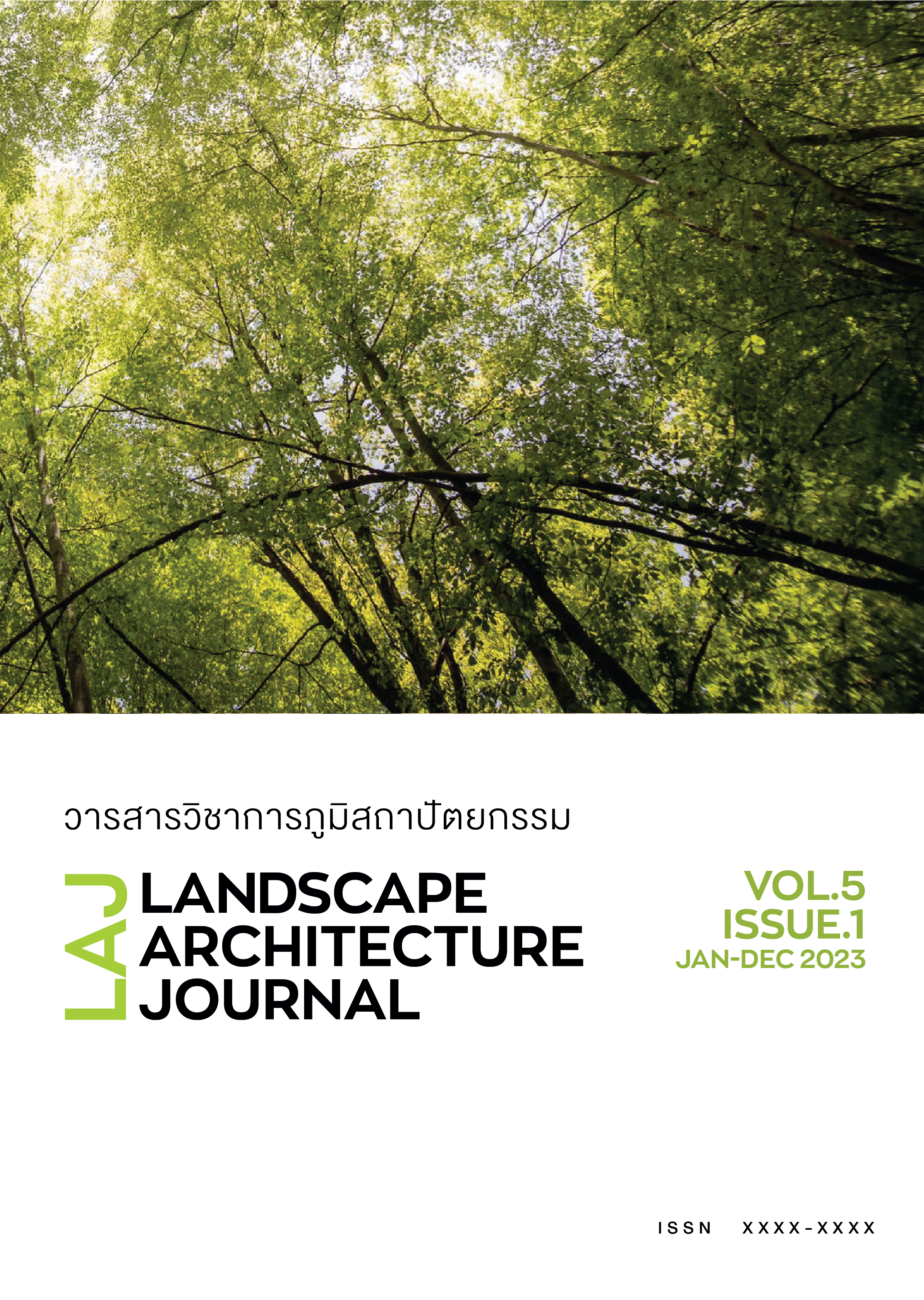Research-based Public Park Design for Disabled People: A Case Study of Aquatic Center Area, Thammasat University, Rangsit Campus
Main Article Content
Abstract
Public parks are essential urban elements for inclusively promoting physical and mental health to all residents. However, there is inadequate support for people with disabilities in thoroughly using public parks. This research has the main objective to study the character and behavior of using public parks by disabled and related people in order to develop public park design guidelines for disabled people. Primary data was collected through Semi-Structured Interviews with 27 people, including people with disabilities, officers, and caretakers. The 11 coded keyworks can classified into two themes, which are 1) Public Park Use Experience and 2) Arrangement, Requirement, and Recommendation for Spatial Use. Each theme consists of a set of subject matters, which leads to the notion of public park design guidelines for disabled people: “Finding Unity Through Difference.” The idea of this conceptual design is to encourage the inclusiveness of multiple identities and personalities through 8 design guidelines which are 1) Spatial arrangement design, 2) Connectivity Design, 3) Physical Activity Area Design, 4) Relaxation Area Design, 5) Fine Arts Design, 6) Physical Health Promotion Design, 7) Mental Health Promotion Design, and 8) Inclusiveness Promotion Design.
Article Details

This work is licensed under a Creative Commons Attribution-NonCommercial-NoDerivatives 4.0 International License.
References
กรมส่งเสริมและพัฒนาคุณภาพชีวิตคนพิการ กระทรวงการพัฒนาสังคมและความมั่นคงของมนุษย์. (2563). สืบค้นจาก https://www.dep.go.th/th/law-academic/knowledge-base/disabled-person-situation
พัทมน เสลานนท์. (2564). โครงการการศึกษาออกแบบพื้นที่พักผ่อนสาธารณะเพื่อยกระดับคุณภาพชีวิตและส่งเสริมสุขภาวะที่ดีสำหรับคนพิการ.
สำนักงานสวนสาธารณะ สำนักสิ่งแวดล้อม กรุงเทพมหานครฯ. (2564). คู่มือการปฏิบัติงานของสำนักงานสวนสาธารณะสำนักสิ่งแวดล้อม. สืบค้นจาก https://webportal.bangkok.go.th/upload/user/00000231/data/plan64/210910_ParkPlan64.pdf
Anna Chiesura. (2004). The role of urban parks for the sustainable city. Landscape and Urban Planning. Volume 68. Issue 1. 2004. Pages 129-138.
American Planning Association (APA). (2006). Planning and Urban Design Standards, New Jersey, John Wiley & Sons.
Bonaiuto et al. (2003). Landscape and Urban Planning 65. Bilthoven, Netherlands. (p.5-18).
Department of Conservation and Natural Resources (DCNR) of Pennsylvania. (2010). Creating Sustainable Community Parks and Landscapes: A Guide to Improving Quality of Life by Protecting Natural Resources 2nd Edition.
Gulczynska, Anna. (2020). Horticultural Therapy and Gardening – Comparison of Dimensions. Studia Edukacyjne. 347-356. 10.14746/se.2017.46.22.
Samarthyam National Centre for Accessible Environments. (2014). Universal Accessibility Guidelines for Pedestrian, Non-motorized Vehicle and Public Transport Infrastructure. Retrieved from: https://shaktifoundation.in/wp-content/uploads/2014/02/Universal-accessibility-guidelines.pdf
Thaneshwari, Thaneshwari & Kumari, Poonam & Sharma, Rishu & Sahare, H.A. (2018). Therapeutic gardens in healthcare: A review. Annals of Biology. 34. 162-166.
The World Disability Union (WDU). (2019). The Universal Standards Guide for Person with Disabilities. Retrieved from: https://worlddisabilityunion.com/images/contents/FILEdabfc04d877ef5e.pdf
United States Environmental Protection Agency (EPA). (2023). (Meeting Community Needs, Protecting Human Health and the Environment: Active and Passive Recreational Opportunities at Abandoned Mine Lands).

